So, what do you do with all your trash on board?
Let me be clear here that I’m talking about coastal cruising or weekends out of the marina, not giving tips on trash management while crossing an ocean or extended cruising without decent trash service ashore. Both of those situations call for additional “trash management.”
On our very first charter, in the British Virgin Islands, we learned just what a trash-generating society we are. We were amazed by the amount of trash we had in just a few days.
Obviously, the first step is making smart choices when provisioning — see my tips for reducing onboard trash with your provisioning choices. And then get rid of as much cardboard as you can before leaving the dock.
But what then? Most boats don’t have room for a very big wastebasket — or much room to store bags of trash. Compacting your trash is the answer — we can easily go 3 weeks between trash runs without resorting to burning paper or throwing anything in the water.
A lot of “trash” is actually air, so spending a little time to squish it can save a lot of space:
Aluminum Cans
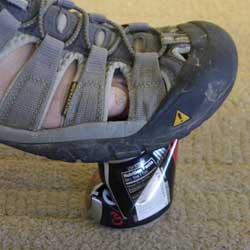 Aluminum cans are probably the easiest item to crush — pinch the sides in a bit, then step down on them. We had a little piece of carpet that we crushed cans on so that we didn’t mar wood or fiberglass.
Aluminum cans are probably the easiest item to crush — pinch the sides in a bit, then step down on them. We had a little piece of carpet that we crushed cans on so that we didn’t mar wood or fiberglass.
We tried to always rinse them out first in some seawater to get rid of any drink residue that would attract bugs, and then kept the crushed cans in a separate bag (and we usually sprayed a bit of ant and roach spray in a new bag).
Why a separate bag? Most marinas will have a place for recycling. And in every little town and fishing village in Mexico (and on land trips in South America and Africa), there is always someone who supports themself by collecting cans and selling them.
We’d either give the bag to the person or just set it next to a trash can — they usually made daily rounds, poking through the bin for cans and it was just a nice surprise for them to find cans already sorted out!
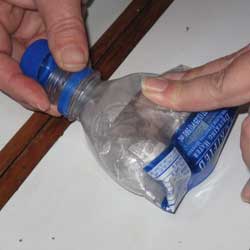 Plastic Bottles
Plastic Bottles
Plastic bottles are a scourge on earth in my opinion — but lots of times, that’s the only way to buy something. Whenever Dave and I go walking, I take along a bag and pick up plastic bottles — it’s amazing how many there are and they just don’t disintegrate with time. But I digress.
Basically, with plastic bottles, you’ve got two options. You can crush them by taking the cap off, step on the bottle and — while still standing on it — put the cap back on so it’ll stay “crushed.” Really thin bottles you may be able to crush (or sometimes roll up) with your hands, as in the photo.
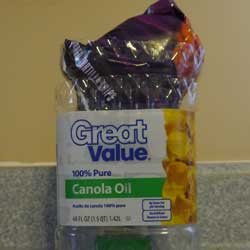 The other option is to cut the bottle in half (kitchen shears usually make a quick job of it), put one half into the other (open end up) and then stuff other trash — usually paper — into the open end to leave as little wasted space as possible (I could probably stuff some small stuff into the bottom half around the top half, too).
The other option is to cut the bottle in half (kitchen shears usually make a quick job of it), put one half into the other (open end up) and then stuff other trash — usually paper — into the open end to leave as little wasted space as possible (I could probably stuff some small stuff into the bottom half around the top half, too).
That’s what I did with this oil bottle — while I can crush them like the water bottle, the heavier plastic doesn’t really crush well. It seems to me that stuffing other stuff into the space works better, but that’s a “gut feeling.”
Jars and Tubs
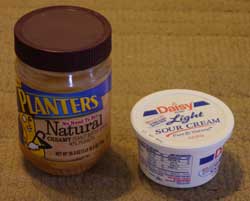 Plastic and glass jars — such as peanut butter or jelly jars — and plastic tubs such as those used for margarine, cream cheese and sour cream aren’t just trash. They’re my garbage containers!
Plastic and glass jars — such as peanut butter or jelly jars — and plastic tubs such as those used for margarine, cream cheese and sour cream aren’t just trash. They’re my garbage containers!
Anything with a wide mouth and securely-closing lid is great for collecting food scraps. Potato peelings, tomato stems, bacon grease, onion skins, egg shells, coffee grounds . . . all that stuff has to go somewhere. And if you just dump it in the trash, it’ll get to stinking pretty quickly and attract bugs.
Instead, I’d put it in a jar that was already in the trash (if you have a coffee can or plastic container, they’re wonderful) and kept the lid on it. If I had a bit of extra room in the refrigerator, I’d stick it in there so it wouldn’t be as stinky when I opened it to add more.
In an ideal world, you’d find a compost pile to put this on when ashore, but I’ve never run across a “public” compost pile so it ends up going in the trash.
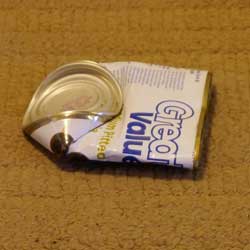 “Tin” Cans
“Tin” Cans
It used to be so easy to deal with tin cans — cut both ends off, stick them in the can and flatten it. Then they started making these cans where you can’t cut the bottoms off. I used to think I couldn’t crush these . . . but with a little practice I discovered that I could and it really cut down on the volume of trash aboard.
I’ve found that I can still do a pretty good job of flattening them. Stick the lid inside, semi-flatten the open end (to get it started), then step down from the closed end to sort of fold it over.
Again, we always do this on a piece of carpet to keep from marring the floor. Well, I say “we” but Dave took this as being his job while I was cooking (he is emphatically NOT a cook).
Bottom Line
Between getting rid of a lot of packaging before we left the dock and compacting our trash, we could go two to three weeks and only fill one kitchen-size (13 gallon) trash bag, which we’d keep in the lazarette. We had just a small bin in the galley area and every few days Dave would empty it into the bigger bag. Then, when we’d “go to town” or back to a marina — wherever there was trash service — we’d get rid of it.
Another advantage of compacting your trash: in some places, you’re charged a “per bag” fee for trash disposal. Why pay for three or four bags when you can crush the contents and just have one bag?
Flatten the learning curve with practical how-to info that gives you the confidence to step into life aboard.
Start Learning Today

Carolyn Shearlock has lived aboard full-time for 17 years, splitting her time between a Tayana 37 monohull and a Gemini 105 catamaran. She’s cruised over 14,000 miles, from Pacific Mexico and Central America to Florida and the Bahamas, gaining firsthand experience with the joys and challenges of life on the water.
Through The Boat Galley, Carolyn has helped thousands of people explore, prepare for, and enjoy life afloat. She shares her expertise as an instructor at Cruisers University, in leading boating publications, and through her bestselling book, The Boat Galley Cookbook. She is passionate about helping others embark on their liveaboard journey—making life on the water simpler, safer, and more enjoyable.
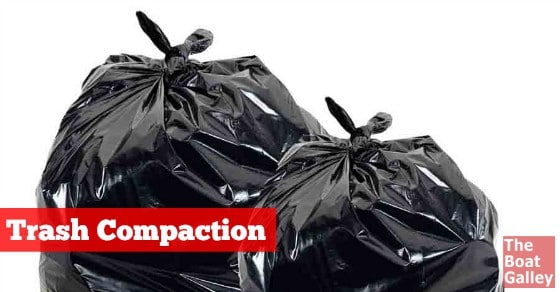







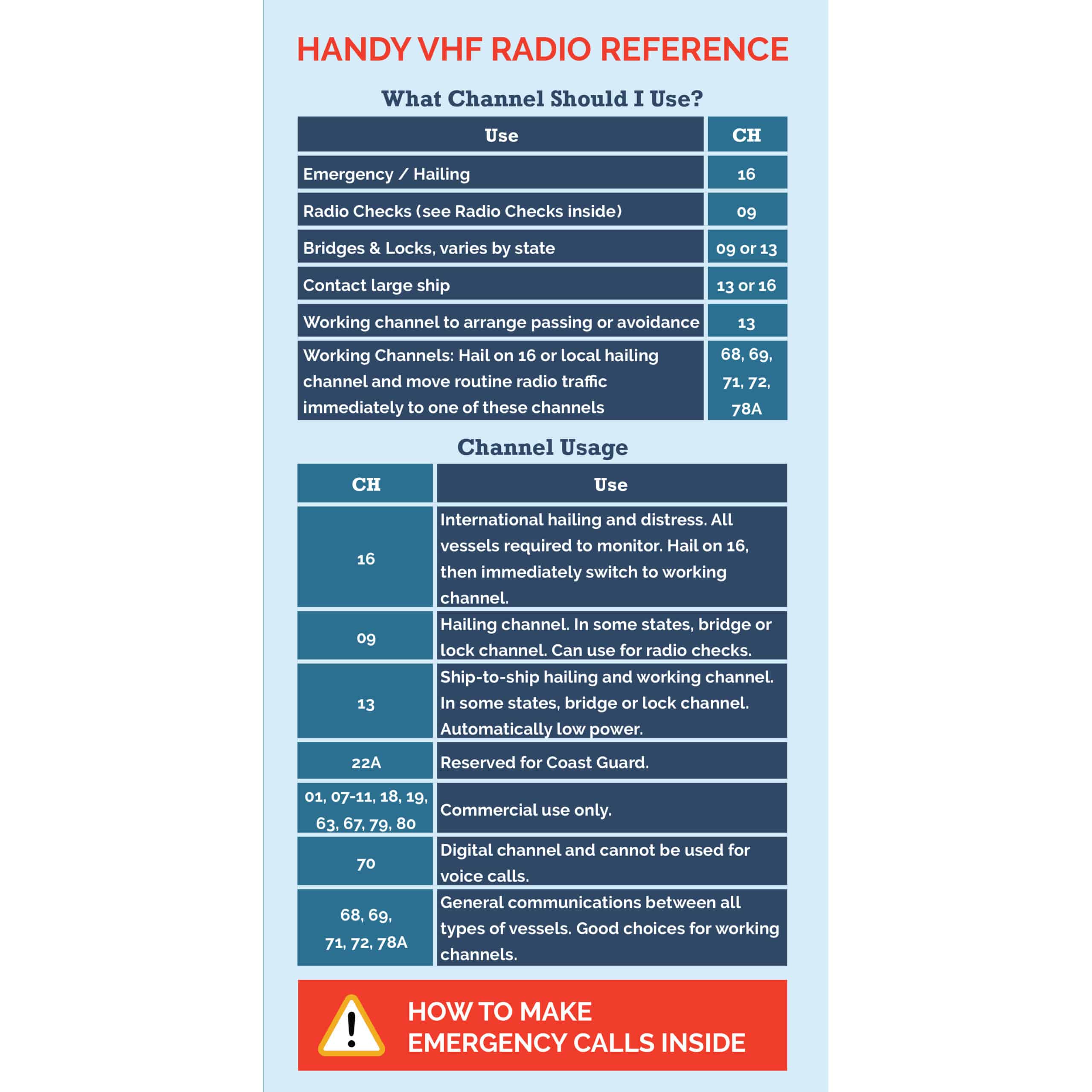

Katie says
Great ideas Carolyn – I especially love the dedicated carpet for mashing of cans – perfect!
Ed Robinson says
All good pointers. On land we seemed to fill a bag every day. On the boat we can go two weeks before filling a bag.
Court Crosby says
I bolted an old door hinge between two pieces of oak flooring and use it to get cans really flat.
Richard says
I have a small shop vac for cleaning up spills and the bilge. It’s also great to flatten out the air volume in your trash bags to save space.
Paul Schroder says
I don’t know how much bacon grease you produce but I get about a pint every six weeks or so. I use it for cooking but any “extra” I save up for making soap. If you let it cure and get good and hard, it makes great laundry soap. Just google bacon grease or bacon fat soap recipes. Also very good on oily/dirty hands. If you spread it on cardboard or paper, it burns fantastically!
Doug Purdy says
We put a paper shopping bag inside a plastic garbage bin that is as high as the bag.. We then line it with a plastic garbage bag. Stomp garbage with your left or right garbage compactor, and tie off the bag, and fold the paper bag down and duct tape it closed. It creates a garbage cell of sorts that is stackable and sealed with the plastic bag protected from punctures.
Reggie Good says
We have a manual trash compactor the size of a kitchen garbage can on our boat and in our kitchen at home. Works great.
Wanita says
In Nova Scotia, you can’t crush the drink cans the way you show as it is difficult for the recycling machine to process/separate them. Crushing them on their side you can do.
So many rules in recycling where ever you cruise!